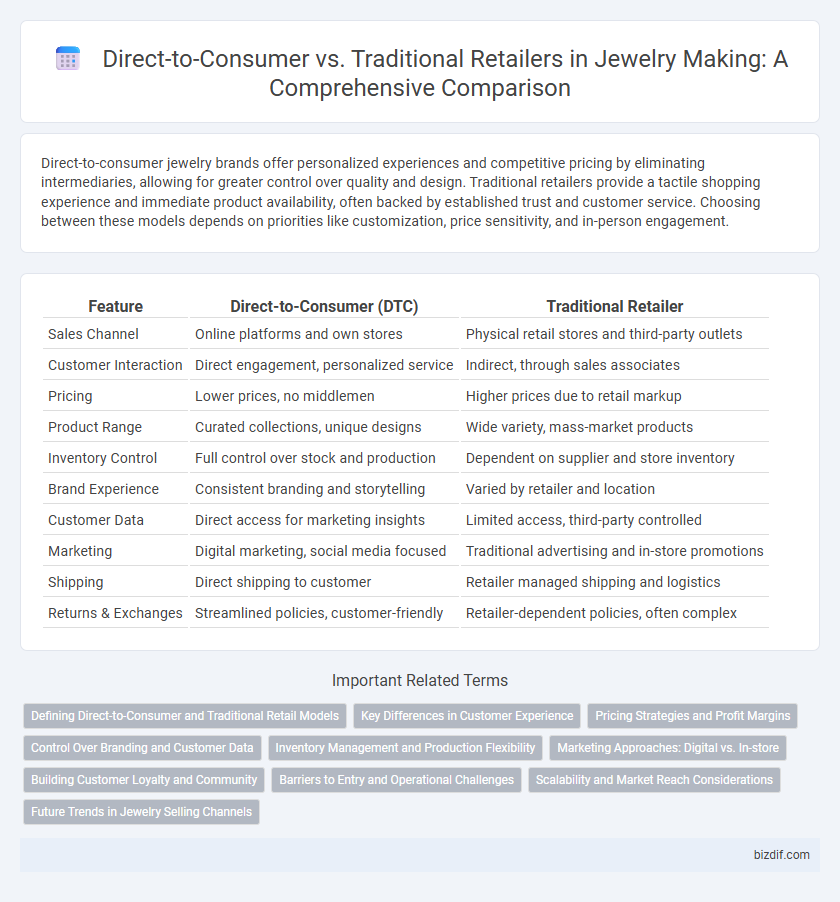Direct-to-consumer jewelry brands offer personalized experiences and competitive pricing by eliminating intermediaries, allowing for greater control over quality and design. Traditional retailers provide a tactile shopping experience and immediate product availability, often backed by established trust and customer service. Choosing between these models depends on priorities like customization, price sensitivity, and in-person engagement.
Table of Comparison
| Feature | Direct-to-Consumer (DTC) | Traditional Retailer |
|---|---|---|
| Sales Channel | Online platforms and own stores | Physical retail stores and third-party outlets |
| Customer Interaction | Direct engagement, personalized service | Indirect, through sales associates |
| Pricing | Lower prices, no middlemen | Higher prices due to retail markup |
| Product Range | Curated collections, unique designs | Wide variety, mass-market products |
| Inventory Control | Full control over stock and production | Dependent on supplier and store inventory |
| Brand Experience | Consistent branding and storytelling | Varied by retailer and location |
| Customer Data | Direct access for marketing insights | Limited access, third-party controlled |
| Marketing | Digital marketing, social media focused | Traditional advertising and in-store promotions |
| Shipping | Direct shipping to customer | Retailer managed shipping and logistics |
| Returns & Exchanges | Streamlined policies, customer-friendly | Retailer-dependent policies, often complex |
Defining Direct-to-Consumer and Traditional Retail Models
Direct-to-consumer (DTC) in jewelry making involves designers selling products directly to customers through online platforms or branded stores, eliminating intermediaries. Traditional retail models rely on third-party retailers or wholesalers to distribute jewelry, often resulting in higher prices and less direct customer engagement. DTC models prioritize personalized shopping experiences and greater profit margins by controlling brand communication and customer data.
Key Differences in Customer Experience
Direct-to-consumer jewelry brands offer personalized shopping experiences with customized designs and direct communication, enhancing customer engagement and satisfaction. Traditional retailers provide the tactile advantage of in-store browsing and immediate product access but often lack the tailored interactions found in DTC models. The direct-to-consumer approach leverages online platforms for seamless customization and faster feedback, contrasting with the more transactional and inventory-limited nature of traditional retail stores.
Pricing Strategies and Profit Margins
Direct-to-consumer jewelry brands often implement competitive pricing strategies by eliminating intermediaries, enabling higher profit margins while offering consumers lower prices. Traditional retailers face higher overhead costs from physical storefronts and supply chain markups, which typically result in increased retail prices and narrower profit margins. Leveraging data analytics, direct-to-consumer models optimize dynamic pricing, enhancing profitability and customer engagement in the evolving jewelry market.
Control Over Branding and Customer Data
Direct-to-consumer jewelry brands maintain full control over branding, allowing for consistent messaging and tailored customer experiences that strengthen brand identity. They also collect valuable first-party customer data, enabling personalized marketing strategies and improved product development. Traditional retailers often limit this control, sharing customer data and brand presentation with multiple intermediaries, which can dilute brand consistency and hinder targeted engagement.
Inventory Management and Production Flexibility
Direct-to-consumer jewelry brands benefit from real-time inventory management, reducing overstock and allowing for just-in-time production that adapts quickly to market trends. Traditional retailers often face challenges with larger inventory holdings and slower production cycles, limiting flexibility and increasing storage costs. Streamlined supply chains in direct sales enable rapid design modifications and personalized offerings, enhancing customer satisfaction and operational efficiency.
Marketing Approaches: Digital vs. In-store
Direct-to-consumer jewelry brands leverage digital marketing strategies such as social media advertising, influencer collaborations, and targeted online campaigns to engage customers and personalize their shopping experience. Traditional retailers rely on in-store marketing techniques including product displays, customer service interactions, and experiential events to drive purchases and build brand loyalty. The shift towards digital channels allows direct-to-consumer brands to gather real-time consumer data and optimize marketing efforts more effectively than traditional retail environments.
Building Customer Loyalty and Community
Direct-to-consumer jewelry brands foster strong customer loyalty by creating personalized shopping experiences and engaging directly through social media and exclusive online communities. Traditional retailers often rely on in-store interactions and broader marketing campaigns but may struggle to build the same level of intimate customer connection. Establishing a direct relationship allows jewelry makers to gather valuable feedback, tailor offerings, and cultivate a passionate community around their brand.
Barriers to Entry and Operational Challenges
Direct-to-consumer jewelry brands benefit from lower barriers to entry by bypassing traditional retail markups and reaching customers directly through e-commerce platforms, reducing upfront costs related to physical store operations. Traditional retailers face significant operational challenges, including high overhead expenses, complex supply chain logistics, and maintaining extensive inventory across multiple locations. Both models contend with customer acquisition costs, but direct-to-consumer brands must also invest heavily in digital marketing and brand differentiation to compete effectively.
Scalability and Market Reach Considerations
Direct-to-consumer jewelry brands leverage e-commerce platforms to scale rapidly, reaching global markets without the limitations of physical storefronts. Traditional retailers depend on established local presence and wholesale partnerships, which can slow expansion but offer trusted customer experiences and brand visibility. Digital analytics and targeted marketing enable DTC models to optimize inventory and personalize outreach, driving efficient scalability beyond traditional retail constraints.
Future Trends in Jewelry Selling Channels
Direct-to-consumer (DTC) jewelry brands leverage digital platforms to enhance personalized shopping experiences, utilizing augmented reality and AI-driven customization tools to meet evolving consumer demands. Traditional retailers are increasingly adopting omnichannel strategies, combining physical stores with virtual showrooms to maintain competitive advantages in the future market landscape. Emerging trends indicate a growing emphasis on sustainability and ethical sourcing, with both channels integrating blockchain technology for transparent supply chain verification.
Direct-to-consumer vs Traditional retailer Infographic

 bizdif.com
bizdif.com